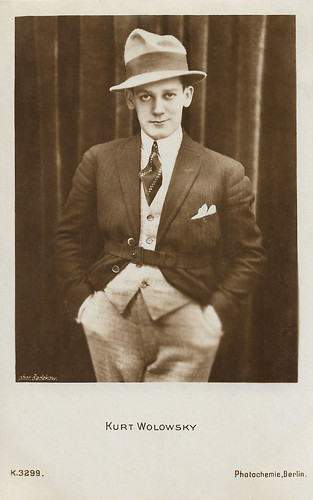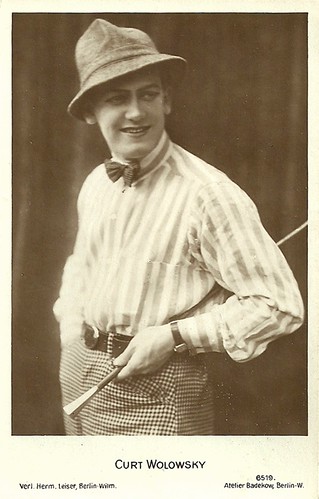
German postcard by Photochemie, no. K. 3299. Photo: Badekow.
Three terrible tales
Born in 1897 in Berlin, Kurt Wolowsky debuted on screen in 1915 at the Berlin company Oliver-Film, opposite Jakob Tiedtke and Rosa Valletti in Eine Dach-Tragödie/A roof tragedy (Paul Otto, 1915).
In Rudolf del Zopp's Eiko production film Muttersöhnchen/Mama's boy (1916) Wolowsky played the lead.
Impressive was his part as young Hoffmann in Hoffmans Erzählungen/Tales of Hoffmann (Richard Oswald, 1916), a liberal adaptation of Jacques Offenbach operetta 'Les contes de Hoffmann', which in its turn was loosely based on Prussian writer E.T.A. Hoffmann's various short stories and novels.
In the Jena of around 1800 young Hoffmann spins three terrible tales around the men who live under one roof with him and his uncle and aunt, and whom he hates. The film had an all-star cast with Werner Krauss (who had his film debut in this film), Lupu Pick, Friedrich Kühne, Alice Hechy, Ressel Orla, and many others.
David Anwwn Jones, in the volume 'The Palgrave Handbook of Steam Age Gothic', describes how young Hoffmann escapes from the back of his family's villa, revealing the total decay of the cityscape as the backside of the "comfortable pre-Biedermeier parlor", almost like a commentary on the war that "ripped apart the comfortable civilization".

German postcard by Verlag Hermann Leiser, Berlin, no. 6522. Photo: Atelier Badekow, Berlin.

German postcard by Ross Verlag, no. 1147/1, 1927-1928. Photo: Kindler, Berlin.
The man with the iron fist
After another Oswald film, Zirkusblut/Circus blood (Richard Oswald, 1916) starring Bernd Aldor, Kurt Wolowsky was away from the sets for a while.
He may have returned to acting at the Lessing Theater where he was employed by the mid-1910s. He returned to film acting in 1922, but now as a supporting actor.
He acted in seven films in the 1920s: Die Tochter Napoleons/Napoleon's daughter (Friedrich Zelnik, 1922) starring Lya Mara and Ludwig Hartau, Die Brigantin von New York/The brigandess of New York (Hans Werckmeister, 1924) with Lotte Neumann in the lead, the Goethe adaptation Götz von Berlichingen/Goetz von Berlichingen of the Iron Hand (Hubert Moest, 1925) with Eugen Klöpfer as the man with the iron fist, Der Mann im Sattel/The Man in the Saddle (Manfred Noa, 1925) with Ernö Verebes in the title role as jockey who is in the grip of a perfid countess (Colette Darfeuil), Das edle Blut/The noble blood (Carl Boese, 1926/1927) with Eugen Burg and Hanna Ralph, and Vom Leben getötet. Bekenntnisse einer 16jährigen/Killed by life. Confessions of a 16 year old (Franz Hofer, 1927).
Wolowski's last silent film was Geschminkte Jugend/Painted Youth (Carl Boese, 1928/1929). In this last film about three young girls on the loose, he is killed by the brother (Wolfgang Zilzer) of one of the three girls (Toni Van Eyck) during a secret day out and a forced stay-over at an inn. The film was based on a real event, the 'Steglitzer Schülertragödie', which was filmed again twice in 1960 and 2004.
After a longer interruption, Wolowsky made a one-time comeback in the sound film era of the 1930s. His last film role was in the sound film Einmal werd' ich Dir gefallen/One day you'll like me (Johannes Riemann, 1937), starring Paul Hörbiger. In 1985, nearly fifty years later, Kurt Wolowsky died in New York City. He was 88.

German postcard by Verlag Hermann Leiser, Berlin, no. 6519. Photo: Atelier Badekow, Berlin.
Sources: Filmportal.de, Wikipedia (German), and IMDb.
This post was last updated on 16 April 2022.
No comments:
Post a Comment